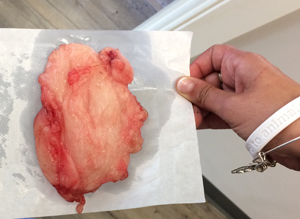Can an Old Dog Teach You Something New?

Logan at Pre-Op with his Sisters
Last week I had to make a determination to have my dog, a 12-year-old black lab, to undergo surgery to remove what we believed to be a lipoma. Lipoma’s are commonly found in animals, as well as people. Perhaps you have noticed one of these lumps on yourself and were curious about what it may be. A lipoma is benign tumor composed of adipose tissue (fat). It is more common in adults 40-60 years old, but are also found in younger adults and children. I myself have several small Lipoma’s in my lower back. They are typically asymptomatic. They are soft and squishy and tend to not be of any significant pain or discomfort.
However, although they may be benign in the sense of a tumor, they can, at times cause pain when they develop around tissues such as nerves, muscles and ligaments. When this occurs, this may cause shooting pains from nerve entrapments, lameness or even changes in basic movement patterns, depending upon their size. Regardless of if you are a dog or a person, Lipoma’s are all the same. We treat many patients at The Boston Bodyworker who have what we may feel as a Lipoma. As a therapist, it is our job to indicate these findings to you if you are unaware of them (many are) and we recommend getting them checked out by a doctor just to be certain they are nothing more.
I wanted to use this platform to not only educate you, but to also show you what a Lipoma actually looks like. In the case of Logan (my dog), he has developed multiple Lipoma’s all over his body as he has grown older. Lipoma’s in labs are very common and not usually something to be alarmed about. They are certainly worth getting checked out by a doctor, but unless there are other symptoms that accompany them such as appetite loss, mood changes or elevated enzymes in the liver, symptoms that are typical with malignant tumors, doctors will commonly tell you to leave them alone. In Logan’s case, we monitor them and chart them with the doctor.
Logan began to experience some lameness in his hind left leg a few months back. Unlike, patients we see here, he could not vocalize what he was feeling. The doctor felt that since he was getting older, it could be a matter of arthritis developing in his hips or perhaps some dysplasia. Test did not indicate this, but again, without Logan’s ability to speak, it would require x-rays to determine this. After seeing him get increasing weaker and unable to sustain a walk of more than 10 minutes, I felt that it would be best to have the Lipoma’s on his hindquarter removed with the hope that doing this would provide relief to an entrapped nerve or muscle.
 Here is an image of the Lipoma that was removed from Logan. As you can see, it is one HUGE piece of fat. It was slightly larger than a softball. The doctor reported that it was wrapped in and around his hamstrings and Achilles as well as some nerves. “Logan has the hips of a 6 year old,” stated the Vet when he showed me his X-rays. It is still early in his recovery, but we are hopeful that he will be returning to his normal activities of nightly 2-mile walks and catching Frisbees before long.
Here is an image of the Lipoma that was removed from Logan. As you can see, it is one HUGE piece of fat. It was slightly larger than a softball. The doctor reported that it was wrapped in and around his hamstrings and Achilles as well as some nerves. “Logan has the hips of a 6 year old,” stated the Vet when he showed me his X-rays. It is still early in his recovery, but we are hopeful that he will be returning to his normal activities of nightly 2-mile walks and catching Frisbees before long.
There is no way to avoid Lipoma’s. Some of us are more predisposed to them than others. If you do notice any ‘bumps’ or ‘lumps’, we suggest that you always get them checked out by your doctor. Palpation of these is never 100% accurate and early detection may be the difference between life and death in some cases.
Ready to #feelbetter?
You're just a click away from a wicked good massage!
-

60 Minute Massage Gift Card
$170.00 Add to cart -

90 Minute Massage Gift Card
$255.00 Add to cart -

Mini Aer Small Room Air Purifier
$149.00 Add to cart -
Sale!

Thera-Pearl Sports Pack/Hot Cold
Original price was: $14.99.$12.99Current price is: $12.99. Add to cart -

3 Somadome Sessions Gift Card
$135.00 Add to cart -

20 Minute Somadome Gift Card
$45.00 Add to cart -
Sale!

TheraBand® Stretch Strap
Original price was: $19.99.$14.99Current price is: $14.99. Add to cart -

TheraBand CLX Connective Loop
$14.99 Select options
Muscle Strains
A strain, sometimes referred to as a pulled muscle, is a muscle injury produced by excessive tensile stress that causes fibers to tear within the tissue. A muscle strain does not usually result from excess stretch alone, but from a combination of tension and contraction. Muscle strains can develop when excess tension is placed on…
Read MoreShin Splints or Compartment Syndrome?
One of the most common overuse injuries affecting the lower extremity is the condition known as shin splints. While the term shin splints routinely is used, especially among the athletic population, it does not represent a specific clinical pathology. Instead, it describes chronic shin pain resulting from overuse. It occurs in two regions of the…
Read MoreAn Alternative Approach to Stretching
Clinicians, athletes and rehabilitation specialists advocate stretching as a means for injury prevention and treatment. The primary purpose of any stretching technique is to enhance pliability and flexibility in the soft tissues. It is also routinely incorporated with massage in the treatment of pain and injury conditions. There are many different stretching techniques, which all…
Read MoreGanglion Cysts
The highly refined palpation skills of massage practitioners are such that we often identify tissue abnormalities before the client is aware of them. An indication that we should refer a patient for further evaluation is when we identify something we aren’t sure of but know shouldn’t normally be there. One such example may occur with…
Read MoreWhat Is the “End Feel”?
Some of the most valuable assessment information is derived from relatively simple procedures such as passive range-of-motion tests. While many massage practitioners have been exposed to the fundamental concepts of active and passive range-of-motion testing, most have not learned how to use this information effectively in a clinical environment. In this article, we will focus…
Read MoreHow Accurate Is That Test?
Physical assessment is considered one of the most accurate ways to assess function of the locomotor tissues of the body. While we can often gain valuable information about structural problems through high-tech diagnostic procedures like X-ray or MRI, these procedures tell us very little about the function of the tissues involved in creating and limiting…
Read MoreWhen Is It Tendinitis?
Tendinitis is one of the most common diagnoses for soft tissue pain resulting from repetitive motion. As repetitive motion disorders have dramatically increased, so has the incidence of tendinitis. However, recent investigations into the cellular nature of tendon pathologies have brought forth interesting discoveries that may alter the way tendinitis is treated. In this month’s…
Read More- « Previous
- 1
- …
- 18
- 19
- 20

